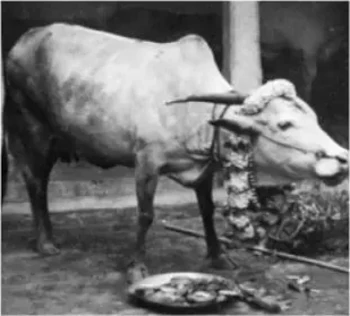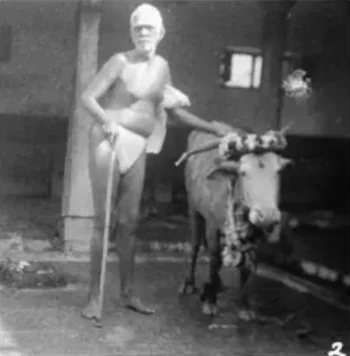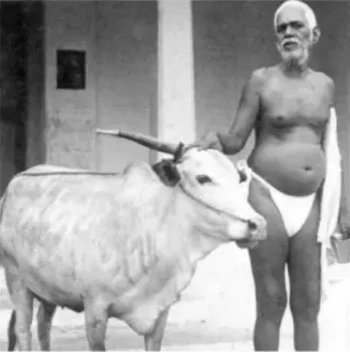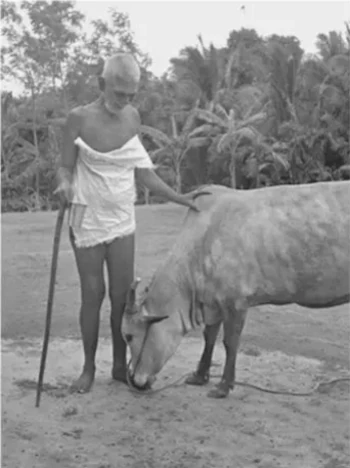A Cow's Mukti
A.Devaraja Mudaliar
Sometime in 1926, four years after Sri Bhagavan had come to live at the foot of the Holy Hill beside the samadhi of the Mother, one Arunachala Pillai of Kumaramangalam, near Gudiyatham, entered the Ashram with a cow and her young female calf and offered them to Sri Bhagavan in token of his devotion. Bhagavan tried to dissuade him, pointing out that there were no proper facilities at the Ashram for looking after the cow and calf and telling him that since he had already presented them to Bhagavan, that it was enough and he could now take them back with him and look after them not as his but as Bhagavan‟s. All this persuasion, however, was lost on the devotee who insisted on leaving the two animals with Sri Bhagavan and exclaimed: “I have made my humble gift and would not take it back even if my throat were to be cut.”

Seeing his insistence and the devotion behind it, one Ramanatha Dikshitar who was then living near Sri Bhagavan and who passed away a few years before him after some forty years of his gracious company, declared energetically: “I will look after the cow and the calf.” Now this Dikshitar was a frail, puny, insignificant looking man from whom one would normally never expect any vehemence, but on this occasion he seemed like one inspired and cried out, smiting his chest: “Here I am! I make myself responsible for the upkeep of these animals.” So it was that, owing to the insistent devotion of Arunachala Pillai and the unusual vehemence of Ramanatha Dikshitar, the cow and her calf came to live at the Ashram. Ramanatha Dikshitar tended the animals carefully and with great kindness for some three months, after which they were given into the care of one Pasupathi Aiyar who lived in the town and kept a dairy. They were well cared for by him. About a year later he set out one day to bathe in Pallitirtham Tank and to have darshan of Bhagavan and brought the cow and her calf with him to show to Bhagavan.

The calf seems to have noted the road and the layout of the Ashram, because next morning she came again by herself and appeared before Sri Bhagavan. Such was the attraction that Sri Bhagavan had for her, that from that day onwards she used to come alone from the town every morning, spend the day at the Ashram, and find her way back to Pasupathi Aiyar‟s house in the town in the evening. Moreover, while at the Ashram, her attraction to Sri Bhagavan was so strong that she would scarcely leave His presence. He, for his part, treated her very graciously and with his own hands gave her plantains or any delicacy that was brought to him. Thus passed several happy years of almost continuous satsang (association) with Sri Bhagavan, during which time she came to be known affectionately at the Ashram as Lakshmi.
In 1930, Lakshmi gave birth to a calf and she and her young one were brought to live permanently at the Ashram. Thereafter she remained one of the most prominent of the Ashram residents.
Sri Bhagavan has recounted a number of incidents in the life of Lakshmi testifying to her almost human intelligence. She used to come to Sri Bhagavan regularly at meal-time and accompany him to the dining-hall. Indeed, so punctual was she that if Sri Bhagavan was engaged in anything and had forgotten the time, he would turn and look at the clock when he saw Lakshmi come in and would see that it was just meal-time. She would go straight up to Sri Bhagavan, as though her devotion gave her a special right to him, taking no notice of the Ashram inmates or visitors.

At that time a garden was being made at the Ashram with some difficulty owing to water shortage, and vegetables were grown for the kitchen. It sometimes happened that Lakshmi broke in and made havoc of the young plants and those in charge of the garden would come and complain to Sri Bhagavan. He, however, always took her side and defended her: “She is not to blame. She went where she found good food. If you didn‟t want her to go there you ought to have fenced the garden in properly to keep her out.” Now that there were Ashram workers in charge of the cattle and garden, they no longer allowed Lakshmi to go to Sri Bhagavan so frequently or spend so much time with him, but whenever she could slip away she would go to him, be greeted and patted by him, receive some bananas or whatever else was available and then go back.
As the Ashram grew the number of cattle kept by it increased and a fine stone cow-house was built. On the day of the laying of the foundation stone Lakshmi walked into the presence of Sri Bhagavan shortly before the time fixed for the ceremony and led him back there, she going first and Sri Bhagavan following. On the day of the ceremonial opening of the cow- house it was decided that she should be the first to enter. She was bathed and decorated for entering her new abode, but then she slipped away and went to Sri Bhagavan and sat down before him. She would not budge until he went too, so that he was the first to enter her new house and she stepped in behind him.
As the Ashram grew its cattle population also increased. Lakshmi herself added nine of her progeny to the number, and it is remarkable that no less than three of her calves were born on the exact day of Sri Bhagavan‟s Jayanthi (birthday according to the Hindu calendar). Thus Lakshmi continued through the years as one of the favoured devotees of Sri Bhagavan. As with many human devotees, the constant association of the early years gradually became unnecessary and occasional visits sufficed to sustain the flow of his Grace. Whenever she visited him he would pay attention to her, pat her, stroke her and feed her with plantains, rice cakes and sweet rice. She was particular about her food. She did not much like ordinary plantains, so when she came Bhagavan would show great solicitude and say, “Go and see if there are not any hill-fruit”; and the attendants would run about attending to the needs of his devotee. Her great devotion and the possessive way in which Lakshmi would always approach Sri Bhagavan, and the great kindness and attention he showed her, convinced many of the devotees that there was some special bond between them and that although Lakshmi now wore the form of a cow, she must have attached herself to Sri Bhagavan and won his Grace by love and surrender in her previous birth. It seemed hard to explain in any other way the great solicitude and tenderness that Sri Bhagavan always showed in his dealings with her, because, although he was all love and kindness and had solicitude for all, he was normally very undemonstrative and the open expressions of his Grace that Lakshmi used to receive from him were quite exceptional.

Indeed, many of those who had been for a long time in close touch with Sri Bhagavan and with the life of the Ashram believed that Lakshmi was a reincarnation of Keeraipatti, the "Old Lady of the Greens‟, who had known Sri Bhagavan from his earliest days at Tiruvannamalai and had shown very great devotion to him during the years at Virupaksha Cave. She served him in such ways as she could and occasionally prepared food for him almost up to her death in 1921. Sri Bhagavan never definitely stated that Lakshmi was this old lady; nevertheless, the belief was supported by various remarks he made spontaneously or in unguarded moments when the circumstances gave rise to them. His constant insistence that the Self is neither born nor reborn and his injunction to realise the Self behind the illusion of birth, death and rebirth explains why he would never say openly that such and such a person was reborn. It is, therefore, not surprising that no one can quote any open statement by Sri Bhagavan about Lakshmi and the "Old Lady of the Greens‟, although many who heard Sri Bhagavan refer to the two on various occasions felt almost certain that they were the same and that the great devotion of the old lady had caused her to return in this humble guise to work out her remaining karma at the feet of Sri Bhagavan. On January 26th 1946, Sri Bhagavan was in a reminiscent mood and gave the following account of the old lady to his devotees: “Keeraipatti was already living at the big temple in the town when I first went there. She stayed at the Subrahmanyam shrine in the temple and used to feed the sadhus. Later she began bringing food to me from a kammala (blacksmith caste) lady, but after some time the kammala lady began to bring the food herself instead of sending it through Keeraipatti. At that time Keeraipatti had matted locks. Later, when I went to live at the Virupaksha Cave, she was staying in Guha Namasivayar Temple and had shaved off her hair. She lived in the mantapam and used to worship the image of Namasivayar and other images carved on its walls and pillars. The priest would come and do puja to the image in the temple, but she used to worship the images on the walls of the mantapam where she stayed and offer food to them. When she got up in the morning she would go out for a walk on the small hill and from there to where our Ashram now is and then on to Skandashram and back to where she was staying. On the way she would collect fuel and cow- dung and carry them in a bundle on her back and hip. She would also gather all kinds of green leaves for cooking. She had only one pot and she would first boil the water for her bath in it and then cook her rice and the sauce for it. Then she would prepare some dish out of the leaves she had gathered, all in the same pot. She would offer the food to the images on the walls and pillars and then come and give it to me, and only afterwards would she go and eat some herself. In the evening she would go into the town to beg, and there was not a house in the town she did not know.”

“She would come to me and say: "A generous woman has given me a handful of broken rice and I have made gruel out of it.‟ But if we went to see there would be a big pot full of broken rice and various other provisions. That was the sort of person she was. She was very much attached to me. I sometimes used to go with her and help her gather her leaves and vegetables, for instance from the drumstick tree. Sometimes also I helped her in cleaning and preparing the vegetables for cooking, and then I would stay and eat with her. She died before we came here, that is before 1922. She was buried just near here, under a tamarind tree opposite the Dakshinamurti shrine.”
<On June 17th 1948, Lakshmi fell ill and on the morning of the 18th it seemed that her end was near. At about 10 o‟clock in the morning Sri Bhagavan went to her. He caressed her and said, “Amma, do you want me to be near you now?” He looked into her eyes and placed his hand on her head as though giving diksha. He put his hand over her heart also and then caressed her, placing his cheek against her face. When he had convinced himself that her heart was pure, free from all vasanas entailing rebirth and centered solely on Bhagavan, he took leave of her and returned to the hall.

Shortly before the end she licked up a little sweet rice that was placed before her. Her eyes were calm and peaceful. She was conscious up to the end and left her body at 11.30 a.m. quite peacefully.
Those who were in close contact with Sri Bhagavan and who observed carefully his treatment of Lakshmi before her death and noted what he said about her, have no doubt at all that he gave Moksha, Deliverance, to her as he did to his mother. She was buried with proper funeral rites and with great ceremony in the Ashram compound near the graves of a deer, a crow and a dog already buried there on Sri Bhagavan‟s instructions. A stone tomb was built over her grave, surmounted by a likeness of her. On the tomb was engraved an epitaph by Sri Bhagavan which makes it quite clear that she attained Liberation. “On Friday, the 5th of Ani, in the bright fortnight, in Sukla Paksham on Dvadasi in Visaka nakshatra in Sarvadhari year, that is on 18-6-48, the cow Lakshmi attained Mukti.”
On my next visit to the Ashram after the tomb was finished, I read the stanza and asked Bhagavan whether the use of the word vimukti in it was just conventional, as when we say that someone has attained samadhi, meaning that he has died, or whether it really meant Nirvana, and he replied that it meant Nirvana.
